Vitamin D and Swimming Exercise Prevent Obesity in Rats under a High-Fat Diet via Targeting FATP4 and TLR4 in the Liver and Adipose Tissue
- PMID: 36360622
- PMCID: PMC9656563
- DOI: 10.3390/ijerph192113740
Vitamin D and Swimming Exercise Prevent Obesity in Rats under a High-Fat Diet via Targeting FATP4 and TLR4 in the Liver and Adipose Tissue
Abstract
The prevalence of obesity has risen in the last decades, and it has caused massive health burdens on people's health, especially metabolic and cardiovascular issues. The risk of vitamin D insufficiency is increased by obesity, because adipose tissue alters both the requirements for and bioavailability of vitamin D. Exercise training is acknowledged as having a significant and long-term influence on body weight control; the favorable impact of exercise on obesity and obesity-related co-morbidities has been demonstrated via various mechanisms. The current work illustrated the effects of vitamin D supplementation and exercise on obesity induced by a high-fat diet (HFD) and hepatic steatosis in rats and explored how fatty acid transport protein-4 (FATP4) and Toll-like receptor-4 antibodies (TLR4) might be contributing factors to obesity and related hepatic steatosis. Thirty male albino rats were divided into five groups: group 1 was fed a normal-fat diet, group 2 was fed an HFD, group 3 was fed an HFD and given vitamin D supplementation, group 4 was fed an HFD and kept on exercise, and group 5 was fed an HFD, given vitamin D, and kept on exercise. The serum lipid profile adipokines, interleukin-6 (IL-6), and tumor necrosis factor-alpha (TNF-α) were analyzed, and the pathological changes in adipose and liver tissues were examined. In addition, the messenger-ribonucleic acid (mRNA) expression of FATP4 and immunohistochemical expression of TLR4 in adipose and liver tissues were evaluated. Vitamin D supplementation and exercise improved HFD-induced weight gain and attenuated hepatic steatosis, along with improving the serum lipid profile, degree of inflammation, and serum adipokine levels. The expression of FATP4 and TLR4 in both adipose tissue and the liver was downregulated; it was noteworthy that the group that received vitamin D and was kept on exercise showed also improvement in the histopathological picture of this group. According to the findings of this research, the protective effect of vitamin D and exercise against obesity and HFD-induced hepatic steatosis is associated with the downregulation of FATP4 and TLR4, as well as a reduction in inflammation.
Keywords: Exercise Physiology; FATP4: (fatty acid transport protein 4); HFD: (high-fat diet); Sports Exercise; Swimming Exercise Vit D: (vitamin D); T2D: (type 2 diabetes); TLR4: (Toll-like receptor 4 antibodies); obesity.
Conflict of interest statement
The authors declare no conflict of interest.
Figures










Similar articles
-
Swimming exercise improves gene expression of PPAR-γ and downregulates the overexpression of TLR4, MyD88, IL-6, and TNF-α after high-fat diet in rat skeletal muscle cells.Gene. 2021 Apr 5;775:145441. doi: 10.1016/j.gene.2021.145441. Epub 2021 Jan 19. Gene. 2021. PMID: 33482280
-
The Impact of Vitamin D Supplementation on Neurodegeneration, TNF-α Concentration in Hypothalamus, and CSF-to-Plasma Ratio of Insulin in High-Fat-Diet-Induced Obese Rats.J Mol Neurosci. 2017 Feb;61(2):247-255. doi: 10.1007/s12031-016-0864-y. Epub 2016 Dec 6. J Mol Neurosci. 2017. PMID: 27921254
-
Dietary alpha- and gamma-tocopherol (1:5 ratio) supplementation attenuates adipose tissue expansion, hepatic steatosis, and expression of inflammatory markers in a high-fat-diet-fed murine model.Nutrition. 2021 May;85:111139. doi: 10.1016/j.nut.2021.111139. Epub 2021 Jan 7. Nutrition. 2021. PMID: 33549947
-
Vitamin A Supplementation during Suckling and Postweaning Periods Attenuates the Adverse Metabolic Effects of Maternal High-Fat Diet Consumption in Sprague-Dawley Rats.Curr Dev Nutr. 2020 Jun 27;4(8):nzaa111. doi: 10.1093/cdn/nzaa111. eCollection 2020 Aug. Curr Dev Nutr. 2020. PMID: 32734136 Free PMC article. Review.
-
Vitamin D Enhancement of Adipose Biology: Implications on Obesity-Associated Cardiometabolic Diseases.Nutrients. 2025 Feb 6;17(3):586. doi: 10.3390/nu17030586. Nutrients. 2025. PMID: 39940444 Free PMC article. Review.
Cited by
-
Exploring the NRF2/HO-1 and NF-κB Pathways: Spirulina Nanoparticles as a Novel Approach to Combat Diabetic Nephropathy.ACS Omega. 2024 May 21;9(22):23949-23962. doi: 10.1021/acsomega.4c02285. eCollection 2024 Jun 4. ACS Omega. 2024. PMID: 38854532 Free PMC article.
-
Association between serum vitamin D concentration and liver fibrosis in diabetes mellitus patients: a cross-sectional study from the NHANES database.Acta Diabetol. 2024 Nov;61(11):1393-1402. doi: 10.1007/s00592-024-02292-3. Epub 2024 Jun 3. Acta Diabetol. 2024. PMID: 38831202
-
The Interplay between Liver and Adipose Tissue in the Onset of Liver Diseases: Exploring the Role of Vitamin Deficiency.Cells. 2024 Sep 30;13(19):1631. doi: 10.3390/cells13191631. Cells. 2024. PMID: 39404394 Free PMC article. Review.
-
The Role of Solute Carrier Family Transporters in Hepatic Steatosis and Hepatic Fibrosis.J Clin Transl Hepatol. 2025 Mar 28;13(3):233-252. doi: 10.14218/JCTH.2024.00348. Epub 2025 Jan 22. J Clin Transl Hepatol. 2025. PMID: 40078199 Free PMC article. Review.
-
From the Sun to the Cell: Examining Obesity through the Lens of Vitamin D and Inflammation.Metabolites. 2023 Dec 20;14(1):4. doi: 10.3390/metabo14010004. Metabolites. 2023. PMID: 38276294 Free PMC article. Review.
References
-
- Karnafel W., Możejko-Pastewka B. Obesity and the risk of type 2 diabetes mellitus and certain types of cancer. Clin. Diabetol. 2015;4:163–171.
-
- Vilarrasa N., Maravall J., Estepa A., Sánchez R., Masdevall C., Navarro M., Alía P., Soler J., Gómez J. Low 25-hydroxyvitamin D concentrations in obese women: Their clinical significance and relationship with anthropometric and body composition variables. J. Endocrinol. Investig. 2007;30:653–658. doi: 10.1007/BF03347445. - DOI - PubMed
-
- Saied E.M., El-Maradny Y.A., Osman A.A., Darwish A.M.G., Abo Nahas H.H., Niedbała G., Piekutowska M., Abdel-Rahman M.A., Balbool B.A., Abdel-Azeem A.M. A Comprehensive Review about the Molecular Structure of Severe Acute Respiratory Syndrome Coronavirus 2 (SARS-CoV-2): Insights into Natural Products against COVID-19. Pharmaceutics. 2021;13:1759. doi: 10.3390/pharmaceutics13111759. - DOI - PMC - PubMed
Publication types
MeSH terms
Substances
LinkOut - more resources
Full Text Sources
Medical
Molecular Biology Databases

